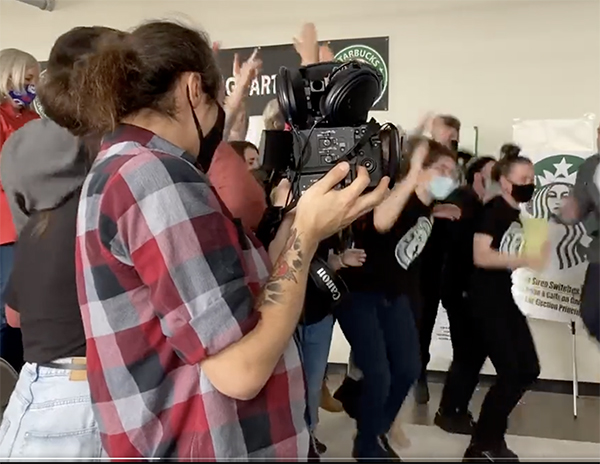Editor’s note: The following are excerpts from a story called, “The Nation’s First Starbucks Just Unioned – Here’s Everything to Know” about the successful union organizing victory in Buffalo, New York, published in Thrillist. See full story on the Thrillist website.
“Why did Starbucks employees in Buffalo unionize? The pandemic was a reckoning for many. While some billionaires made more money than ever, the rest of the country faced mass evictions, a public health care crisis, and unsafe workplaces with low wages. This included workers at Starbucks, who, as essential workers often on the frontlines, were hoping to, as a union, have stronger negotiating power with bosses to secure a better contract. . .
“One shop in Buffalo secured enough votes to unionize by an employee vote of 19 to 8, but there are an additional two shops in the city that are currently in the process of counting votes, and three shops that have announced the intent to unionize. A Starbucks in Mesa, Arizona, announced its intent to form a union in late November. . .
“This is a historic moment in time,” Michelle Eisen, a Starbucks barista who worked at the coffee giant for 11 years, told the press. “This win is the first step in changing what it means to be a partner at Starbucks, and what it means to work in the service industry more broadly. With a union, we now have the ability to negotiate a contract that holds Starbucks accountable to be the company we know it can be and gives us a real voice in our workplace.”
The one shop that secured the votes will be affiliated with the Service Employees International Union. . .
“There are roughly 8,000 company-owned Starbucks stores in the US, according to AP. That equals about 235,00 employees and organizing that many workers is a monumental task. Additionally, the shops that have been attempting to unionize were met with strong resistance from Starbucks executives. In Buffalo, Starbucks sent in top executives and even former CEO Howard Shultz to persuade employees not to unionize. . .
“Starbucks did not want this union effort to succeed. The corporation filed a report with the United States Securities and Exchange Commission, in which the company outlined the predicted effects of widespread unionization among Starbucks employees. “If a significant portion of our employees were to become unionized, our labor costs could increase and our business could be negatively affected by other requirements and expectations that could increase our costs, change our employee culture, decrease our flexibility, and disrupt our business,” the filing states…
“According to Zip Recruiter, the national hourly average for a Starbucks barista is $11.64. In 2019, Starbucks made $24.61 billion in revenue. The company will likely try to improve working conditions and raise wages to sway employees from following in the footsteps of the Elmwood branch, based on initial efforts to prevent the Elmwood branch from unionizing. . .
“The labor movement is picking up steam across the country. Kellog’s workers in Tennessee are on strike, Amazon workers in Alabama are attempting to unionize, and nurses in California made national headlines in November for threatening to strike.
“The number of unionized workers in the US is quite low. The Bureau of Labor Statistics reports that as of January 2021, only 6.3% of private-sector workers (meaning not employed by the government) were unionized. In the food and beverage industry, the percentage of workers in a union dropped even lower, to 1.2%.”
The number of workers who are organizing, unionizing, and striking has increased in 2021. Given the low-wage conditions, and often, unsafe working conditions — along side of huge corporate profits — there is every reason to believe that there is no stopping it!

